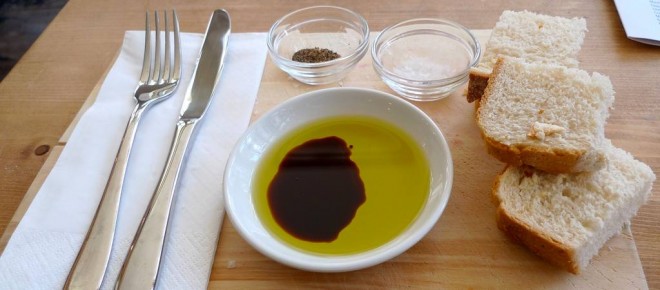Bored with balsamic
I received a press release last week with the title, “Balsamic reduction in cocktails? Who would have thought?” Not me. But on second thought, it might be the perfect calling for that sticky sweet stuff. Remember when it was being drizzled on everything—from steak to strawberries—in restaurants? I do, and I loved it! One of my most memorable meals was at a restaurant in Florence called Aqua al 2, where I had a steak smothered in it. I thought it was the height of sophistication. But that was about twelve years ago. Now, the thought of a fine piece of meat covered in saccharine goo seems gauche, like unitards with snaps in the crotch part.
Share

I received a press release last week with the title, “Balsamic reduction in cocktails? Who would have thought?” Not me. But on second thought, it might be the perfect calling for that sticky sweet stuff. Remember when it was being drizzled on everything—from steak to strawberries—in restaurants? I do, and I loved it! One of my most memorable meals was at a restaurant in Florence called Aqua al 2, where I had a steak smothered in it. I thought it was the height of sophistication. But that was about twelve years ago. Now, the thought of a fine piece of meat covered in saccharine goo seems gauche, like unitards with snaps in the crotch part.
These days, I find the taste of balsamic vinegar intrusive. I don’t want it in olive oil for dipping bread and I never think of putting it in salad dressing, although there was a time when I wouldn’t make a salad without it (now, my go-to vinegar is of the white wine variety.) Come to think of it, I bought a bottle of balsamic over a year ago, thinking I had to at least have it in my pantry, but it still hasn’t been cracked open.
And here’s a real kicker: the stuff I bought—and that everyone buys for about ten bucks a bottle—isn’t even true balsamic vinegar, which, by the by, could be sold by the drop for the same price as gold. It’s so precious that most producers won’t even attempt to sell it—they keep it on hand for special occasions. Its name is derived from balsamum—the Latin word for balsam tree, whose precious aromatic resin was often used medicinally. Real balsamic vinegar is just as precious: it may be little more than fermented, cooked grape must, but you need 100 kilograms of must to produce just one to two litres of true balsamic vinegar. And you also need a little patience: the product must be passed through increasingly small barrels of chestnut, oak, ash and mulberry over the course of 30 to 40 years. No wonder Italian traditionally use it sparingly and ceremonially.
How did balsamic vinegar get to be so popular? There’s a great book by David Kamp called, The United States of Arugula that explains the history of gourmet trends, including our fascination with balsamic vinegar. It started in the 1970s when a little shop called Dean and Deluca first imported a whole whack of the cheap stuff. It wasn’t selling so they encouraged a New York Times writer to do a story on it—something about how it was basically fat free and could be used straight-up on salads. That did it–bottles flew off the shelves. In fact, it became so popular in the early 80s that new factories were built in Italy in order to keep up with the North American demand.
So if the real stuff is next-to-impossible to find here, what exactly are you getting when you buy balsamic vinegar? It’s usually red wine vinegar with some additional sugar and colouring, or grape must that hasn’t been aged according to the rules. It’s not by any means bad. I’m just done with it, for now.